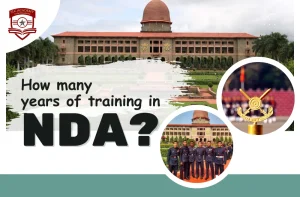In the realm of defense services, two distinguished gateways beckon aspiring candidates — the National Defence Academy (NDA) and the Combined Defence Services (CDS). Both avenues open doors to impactful careers in the armed forces, yet they stand apart in their structures, objectives, and requirements. As individuals contemplate the path best suited to their aspirations, understanding the fundamental differences between NDA and CDS becomes paramount. This exploration aims to unravel the intricacies of these two prominent routes, offering insights into their unique selection processes, career trajectories, and other defining features. Join us on a journey of discernment as we illuminate the distinctions that shape the choices between NDA and CDS.
Notable Differences: NDA and CDS
| Criterion | National Defence Academy (NDA) | Combined Defence Services (CDS) |
|---|---|---|
| Entry Point | After 10+2 education | After graduation |
| Educational Qualifications | 10+2 or equivalent with Physics and Mathematics | Bachelor’s degree from a recognized university or equivalent |
| Age Limit | Generally 16.5 to 19.5 years | Varies; generally 19 to 24 years for IMA, INA, AFA, and 19 to 25 for OTA |
| Mode of Entry | Direct entry after 10+2 through a competitive exam | Entry for graduates through a competitive exam |
| Training Period | Three-year training program before moving to service academies | Shorter training programs at respective service academies |
| Degree of Education | Provides education at the 10+2 level along with military training | Requires completion of a bachelor’s degree |
| Gender Inclusivity | Open to male & female candidates | Open to both male and female candidates |
National Defence Academy (NDA)
The National Defence Academy (NDA) is a prestigious military academy in India that provides training to candidates for the Indian Armed Forces. Established in 1954, the NDA is located in Khadakwasla near Pune, Maharashtra. The academy is a joint services institution where cadets from the Indian Army, Navy, and Air Force train together before they go on to their respective service academies for further pre-commissioning training.
The NDA conducts a three-year program for undergraduate education and military training, after which successful cadets go on to the Indian Military Academy (IMA), Indian Naval Academy (INA), or Air Force Academy (AFA) for specialized training in their chosen service. The academy aims to develop qualities of leadership, camaraderie, discipline, and physical fitness in its cadets.
Admission to the NDA is through a competitive entrance examination, and successful candidates undergo a rigorous selection process that includes written exams, interviews, and medical tests. The NDA is a key institution in shaping the future leaders of the Indian Armed Forces.
Looking for NDA Coaching? check Best NDA Coaching in Chandigarh
History of the National Defence Academy (NDA)

Established on December 7, 1954, the National Defence Academy (NDA) has played a pivotal role in shaping the military leadership of India. Conceived in the post-independence era as a response to the need for a unified training institution for officers of the Indian Armed Forces, the NDA was inaugurated by Prime Minister Jawaharlal Nehru. Situated in Khadakwasla near Pune, Maharashtra, the academy has stood as a symbol of excellence in military education. Its founding principle of providing joint services training to cadets from the Army, Navy, and Air Force has been instrumental in fostering a sense of camaraderie and jointmanship among future leaders.
Over the years, the NDA has evolved to meet the dynamic requirements of the armed forces. The academy’s three-year program not only imparts academic education but also focuses on military training and physical fitness development. Graduates of the NDA, having imbibed the ethos of discipline and leadership, go on to pursue specialized training at the Indian Military Academy, Indian Naval Academy, or Air Force Academy. The NDA’s rich history and its role in producing distinguished military leaders underscore its significance as a cornerstone institution in India’s military heritage.
NDA Admission Requirements
| Requirement | Criteria |
|---|---|
| Nationality | Indian citizen, or subject of Bhutan, or subject of Nepal, or Tibetan refugee settled in India before January 1, 1962 |
| Age Limit | Between 16.5 and 19.5 years |
| Educational Qualifications | – For Army Wing: 10+2 or equivalent |
| – For Air Force and Naval Wings and the Indian Naval Academy: 10+2 or equivalent with Physics and Mathematics | |
| Marital Status | Unmarried |
| Physical Fitness | Good physical and mental health, meeting the prescribed standards |
| Selection Process | Written examination (Mathematics and General Ability Test), followed by an interview and medical examination |
Combined Defence Services (CDS)
The Combined Defence Services (CDS) examination in India, conducted by the Union Public Service Commission (UPSC), serves as a gateway to recruit officers for various defense services. Held biannually, the CDS examination selects candidates for admission into prestigious institutions such as the Indian Military Academy (IMA), Indian Naval Academy (INA), Air Force Academy (AFA), and Officers Training Academy (OTA). The examination encompasses written tests in English, General Knowledge, and Mathematics for IMA, INA, and AFA, while OTA candidates are evaluated in English and General Knowledge. Successful candidates undergo subsequent interviews by the Services Selection Board (SSB) and proceed to their respective academies for comprehensive training, ultimately preparing them for commissioned officer roles in the Indian Army, Navy, and Air Force.
History of the Combined Defence Services (CDS)

The history of the Combined Defence Services (CDS) examination in India traces back to its inception as a crucial mechanism for recruiting officers across the Army, Navy, and Air Force. The CDS examination, administered by the Union Public Service Commission (UPSC), was instituted to streamline the selection process for various defense services. Its roots can be traced to the early years post-independence, with the first CDS examination being conducted to admit officers to the Indian Military Academy (IMA), Indian Naval Academy (INA), Air Force Academy (AFA), and the Officers Training Academy (OTA). Since its establishment, the CDS examination has been held biannually, usually in February and November, playing a vital role in identifying and nurturing leadership for the Indian Armed Forces.
The examination process typically involves a written test covering English, General Knowledge, and Mathematics for IMA, INA, and AFA candidates, while OTA candidates are evaluated in English and General Knowledge. Successful candidates proceed to face interviews by the Services Selection Board (SSB) and subsequently undergo comprehensive training at their respective academies. The CDS examination stands as a testament to India’s commitment to recruiting and developing highly qualified and dedicated officers, ensuring robust and capable leadership in defense services.
CDS Admission Requirements
| Requirement | Criteria |
|---|---|
| Nationality | Indian citizen, or subject of Bhutan or Nepal, or Tibetan refugee (specific conditions apply) |
| Age Limit | – IMA, INA, AFA: 19 to 24 years old – OTA: 19 to 25 years old (for both men and women) |
| Educational Qualifications | – IMA and OTA: Bachelor’s degree from a recognized university or equivalent |
| – INA: Degree in Engineering from a recognized university or institution | |
| – AFA: Bachelor’s degree with Mathematics and Physics at 10+2 level or Bachelor of Engineering | |
| Marital Status | – IMA, INA, and AFA: Unmarried<br>- OTA: Unmarried or married (for both men and women) |
| Physical Standards | Candidates must meet the prescribed physical standards |
| Selection Process | The written examination is followed by an interview conducted by the Services Selection Board (SSB) |
Conclusion
The differentiation between the National Defence Academy (NDA) and the Combined Defence Services (CDS) is evident across various facets, emphasizing diverse routes for individuals aspiring to become military officers. The unique entry points, educational requirements, age limits, and training durations showcase tailored pathways for candidates, allowing them to align their academic backgrounds and career objectives with the specific demands and opportunities offered by these esteemed institutions within the Indian Armed Forces. Whether opting for NDA directly after completing 10+2 education or choosing CDS as a university graduates, individuals can make informed decisions based on their qualifications and aspirations, navigating distinct journeys towards contributing to the nation’s defense forces.






